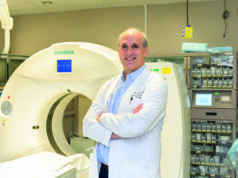
Society of Interventional Oncology (SIO) president William (Bill) Rilling notes that you do not need to be a full time cancer specialist to describe yourself as an interventional oncologist, and that such a prescriptive definition is unhelpful. “Being an interventional oncologist is not about how many cases you do or what percent of your practice is IO, it is a mindset and a dedication to be a part of the cancer care team”, he says.
As interventional radiology (IR) continues to evolve and mature, it seems only natural that the development of subspecialties is a part of that evolution. Currently, IR physicians may focus on a variety of subspecialty practices including peripheral arterial disease (PAD), venous disease, musculoskeletal interventions, women’s health, oncology, and many other new and exciting facets of IR. Encouraging and enabling IR physicians to focus on subspecialties is important to drive innovation and research and subsequently advance practice. From a practical perspective, the diversity and richness of IR practice helps protect us as IR physicians from large losses in patient and procedure volumes as we can often compensate by expanding other areas of our practice. If a drug is developed tomorrow that cures atherosclerosis, many interventional radiologists would lose a significant and important part of their practice, but the vast majority would still have a job.
However, the diversity of IR can also be a weakness. Others who practice in the field of oncology, for example, focus exclusively on caring for cancer patients. Very few medical, surgical, and radiation oncologists spend a significant portion of their time on anything but oncology. This presents a challenge for interventional oncologists, as there are very few IR/ interventional oncology (IO) physicians who practice in IO exclusively. It makes it more difficult for us to be part of “the club.” For example, my practice is about 70% IO, but I also treat vascular malformations, hereditary haemorrhagic telangiectasia (HHT) patients, along with all the other things most of us take care of on a daily basis, and still have to be able to treat aortic catastrophes on call. Having a single-minded focus on oncology is a challenge for most interventional radiologists.
How do we overcome this challenge? In my view, there are several solutions. First and foremost, we must practice multidisciplinary patient care at its highest level with patients as the focus. Cancer care is the ultimate team sport and most cancer patients will have many different oncologic specialists caring for them at various times throughout their cancer journey. This requires the IR/IO physician to participate in multidisciplinary tumour boards, have a meaningful role in treatment decision making, see patients in clinic to discuss options, follow them in clinic to assess response, and understand the evidence basis for IO therapies and the complimentary medical and surgical options. If you are doing these things in your practice, even if IO is not the majority, you are an interventional oncologist. Thus, being an interventional oncologist is not about how many cases you do or what percentage of your practice is IO, it is a mindset and a dedication to be a part of the cancer care team, providing a unique perspective on image guided therapy and hopefully helping to move the field forward.
IR/IO physicians have a significant advantage being part of the cancer team: we have a role in cancer care from diagnosis, through treatment, and continuing to palliation. Therefore, the definition of what are “IO procedures” also warrants additional discussion. Targeted biopsies are becoming increasingly important as personalised cancer therapy expands at an exponential rate. We not only biopsy for initial diagnosis but also to identify new mutations and resistant clones to modify targeted therapy. This is a central and critical role in the cancer patient which will continue to expand. Image guided therapeutic procedures are clearly the realm of IO and we all need to work to expand access to these procedures for our patients. Central to this will be proving the effectiveness of IO treatments by expanding clinical trials and other data collection platforms. IO/IR physicians also play a unique role in palliation and improving quality of life for cancer patients with fluid management techniques, pain palliation, management of malignant bowel obstruction and many other interventions to improve quality of life and decrease narcotic usage in this patient population. This broad spectrum of involvement from diagnosis, to treatment and continuing to palliation is a unique advantage and perspective for IO.
Moving forward, I believe we should continue to encourage and enable subspecialty evolution in IR. This does not weaken IR as a whole but strengthens it. As interventional oncology matures as a subspecialty, we should embrace our inherent and significant advantages as cancer specialists. Currently, as patient reported outcomes, quality of life metrics, and cost effectiveness all become central to cancer therapy, we have a unique opportunity to expand the role of IO and expand patient access to IO therapies. We will need all IO/IR physicians functioning at a high level in their cancer centres to accomplish these goals. The door is open, we simply must walk through it.
William (Bill) Rilling is professor of Radiology and Surgery at the Medical College of Wisconsin, Milwaukee, USA.











